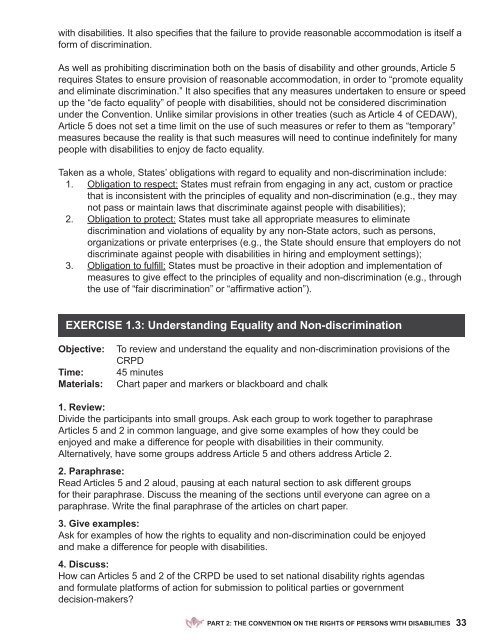Full page photo print - Harvard Law School Project on Disability
Full page photo print - Harvard Law School Project on Disability
Full page photo print - Harvard Law School Project on Disability
You also want an ePaper? Increase the reach of your titles
YUMPU automatically turns print PDFs into web optimized ePapers that Google loves.
with disabilities. It also specifies that the failure to provide reas<strong>on</strong>able accommodati<strong>on</strong> is itself a<br />
form of discriminati<strong>on</strong> .<br />
As well as prohibiting discriminati<strong>on</strong> both <strong>on</strong> the basis of disability and other grounds, Article 5<br />
requires States to ensure provisi<strong>on</strong> of reas<strong>on</strong>able accommodati<strong>on</strong>, in order to “promote equality<br />
and eliminate discriminati<strong>on</strong>.” It also specifies that any measures undertaken to ensure or speed<br />
up the “de facto equality” of people with disabilities, should not be c<strong>on</strong>sidered discriminati<strong>on</strong><br />
under the C<strong>on</strong>venti<strong>on</strong> . Unlike similar provisi<strong>on</strong>s in other treaties (such as Article 4 of CEDAW),<br />
Article 5 does not set a time limit <strong>on</strong> the use of such measures or refer to them as “temporary”<br />
measures because the reality is that such measures will need to c<strong>on</strong>tinue indefinitely for many<br />
people with disabilities to enjoy de facto equality .<br />
Taken as a whole, States’ obligati<strong>on</strong>s with regard to equality and n<strong>on</strong>-discriminati<strong>on</strong> include:<br />
1 . Obligati<strong>on</strong> to respect: States must refrain from engaging in any act, custom or practice<br />
that is inc<strong>on</strong>sistent with the principles of equality and n<strong>on</strong>-discriminati<strong>on</strong> (e .g ., they may<br />
not pass or maintain laws that discriminate against people with disabilities);<br />
2 . Obligati<strong>on</strong> to protect: States must take all appropriate measures to eliminate<br />
discriminati<strong>on</strong> and violati<strong>on</strong>s of equality by any n<strong>on</strong>-State actors, such as pers<strong>on</strong>s,<br />
organizati<strong>on</strong>s or private enterprises (e .g ., the State should ensure that employers do not<br />
discriminate against people with disabilities in hiring and employment settings);<br />
3 . Obligati<strong>on</strong> to fulfill: States must be proactive in their adopti<strong>on</strong> and implementati<strong>on</strong> of<br />
measures to give effect to the principles of equality and n<strong>on</strong>-discriminati<strong>on</strong> (e .g ., through<br />
the use of “fair discriminati<strong>on</strong>” or “affirmative acti<strong>on</strong>”).<br />
eXeRcise 1.3: understanding equality and n<strong>on</strong>-discriminati<strong>on</strong><br />
objective: To review and understand the equality and n<strong>on</strong>-discriminati<strong>on</strong> provisi<strong>on</strong>s of the<br />
CRPD<br />
Time: 45 minutes<br />
materials: Chart paper and markers or blackboard and chalk<br />
1. Review:<br />
Divide the participants into small groups . Ask each group to work together to paraphrase<br />
Articles 5 and 2 in comm<strong>on</strong> language, and give some examples of how they could be<br />
enjoyed and make a difference for people with disabilities in their community .<br />
Alternatively, have some groups address Article 5 and others address Article 2 .<br />
2. Paraphrase:<br />
Read Articles 5 and 2 aloud, pausing at each natural secti<strong>on</strong> to ask different groups<br />
for their paraphrase . Discuss the meaning of the secti<strong>on</strong>s until every<strong>on</strong>e can agree <strong>on</strong> a<br />
paraphrase. Write the final paraphrase of the articles <strong>on</strong> chart paper.<br />
3. give examples:<br />
Ask for examples of how the rights to equality and n<strong>on</strong>-discriminati<strong>on</strong> could be enjoyed<br />
and make a difference for people with disabilities .<br />
4. discuss:<br />
How can Articles 5 and 2 of the CRPD be used to set nati<strong>on</strong>al disability rights agendas<br />
and formulate platforms of acti<strong>on</strong> for submissi<strong>on</strong> to political parties or government<br />
decisi<strong>on</strong>-makers?<br />
PART 2: The c<strong>on</strong>venTi<strong>on</strong> <strong>on</strong> The RighTs of PeRs<strong>on</strong>s wiTh disAbiliTies<br />
33




